Introduction
The purpose of this report is to provide a brief introduction to the civil registration and vital statistics (CRVS) systems in Guatemala.
The information is based on two reports:
- Mapping of the Civil Registration and Vital Statistics System in Guatemala, commissioned and published by the International Development Research Centre (IDRC) and produced by the Organization of American States; and
- Registros Civiles y Oficinas de Identificación (Civil Registries and Identification Offices), published by the Inter-American Development Bank.
It is supplemented with findings from a desk review of online resources. Among other things, the report presents:
- Background information on the country;
- Selected indicators relevant to CRVS improvement;
- Stakeholders’ activities; and
- Resources available and needed to strengthen CRVS systems and coordination.
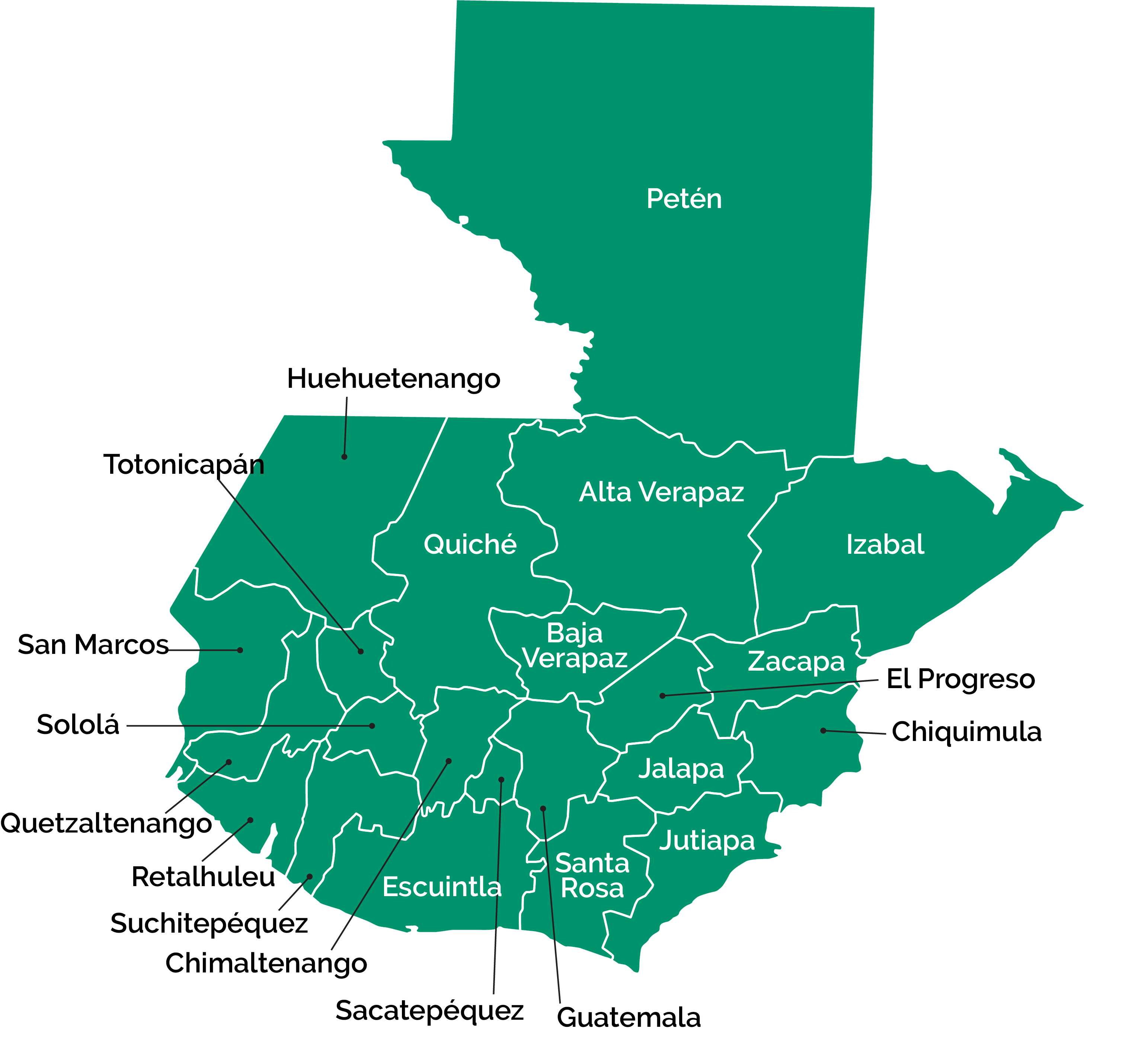
Disclaimer: The boundaries and names shown and the designations used on this map do not imply official endorsement or acceptance by the United Nations.
Country profile
Guatemala is a Central American country that shares borders with El Salvador and Honduras to the south, Mexico to the north, and Belize to the east. Its east coast overlooks the Caribbean Sea, and its southern shore, the Pacific Ocean. Other than the southern coast and northern lands in the Department of Petén, the country is mountainous; rugged terrain or dense forest makes several areas hard to reach.
Guatemala is divided into 22 departments made up of 340 municipalities.
108,889
17,311,085
2018
55.6%
CRVS Dimensions
Birth
| Completeness of birth registration |
96% (2015 |
| Children under 5 whose births were registered |
96% (2011 |
| Births attended by skilled health professionals |
66% (2015 |
| Women aged 15-49 who received antenatal care from a skilled provider |
91% (2015 |
| DPT1 immunization coverage among 1-year-olds |
94% (2018 |
| Crude birth rate (per 1,000 population) |
25 (2017 |
| Total fertility rate (live births per woman) |
2.9 (2017 |
| Adolescent fertility rate (per 1,000 girls aged 15-19 years) |
71 (2017 |
| Population under age 15 |
33% (2020 |
Death
| Completeness of death registration |
92% (2011 |
| Crude death rate (per 1,000 population) |
5 (2017 |
| Infant mortality rate (probability of dying by age 1 per 1,000 live births) |
22.1 (2018 |
| Under five mortality rate (probability of dying by age 5 per 1,000 live births) |
26.2 (2018 |
| Maternal mortality ratio (per 100,000 live births) |
95 (2017 |
Marriages and divorces
| Marriage registration rate |
Not available |
| Women aged 20-24 first married or in union before age 15 |
6% (2017 |
| Women aged 20-24 first married or in union before age 18 |
30% (2017 |
| Divorce registration rate |
Not available |
Vital statistics including causes of death data
| Compilation and dissemination of CR-based statistics |
Available (N/A) |
| Medically certified causes of death data |
Available (N/A) |
Civil registration system
Legislative Framework
Guatemala’s CRVS system was first established by the country’s Civil Code of 1877.
- Political Constitution of the Republic of Guatemala;
- Civil Code;
- National Civil Registry Law (Decree No. 19-2005); and
- Organic Law of the National Statistics Institute (Decree Law 3-85).
Decree 90-2005, Law of the National Registry of Persons, from 2005, creates RENAP as an autonomous entity with its own legal and technical personality. It is in charge of the
- registration of births, marriages, divorces, deaths, and any events or acts having to do with the civil capacity or civil status of individuals;
- procedures inherent within them; and
- issuance and administration of the Personal Identification Document (Documento Personal de Identificación – DPI).
Decision No. 104 2015 of the RENAP Board of Directors, Rules on Civil Registration, governs all civil registry procedures, specifically
- birth;
- recognition;
- marriage;
- marital agreements;
- annulment of marriage;
- divorce;
- common-law marriage, annulment of common-law marriage, and termination of common-law marriage;
- determination of age;
- declaration of absence;
- declaration of presumed death;
- death (including causes of death);
- adoption;
- change of name;
- third-party identification;
- declaration of incapacity;
- guardianship;
- Guatemalan in origin status, naturalized Guatemalan status, and domiciled alien status;
- rectification of certificate and replacement of certificate; and
- events and acts that could alter the civil status or civil capacity of individuals.
Ministerial decisions 106-2016 and 1362016 of the Ministry of Public Health and Social Assistance establish the mechanism that ensures the registration of births occurring in healthcare facilities of the Ministry where RENAP has an auxiliary civil registration office.
Reporting of vital statistics on births to the central government was first mandated by the Civil Code of 1877.
Statistics Institute, Decree Law No. 3-85, January 15, 1985, regulates the institutions that make up the National Statistics System. These institutions are required to apply the methods, procedures, definitions, and technical norms issued by INE, the National Statistics Institute, and to submit all the statistical data and reports they prepare to the INE
for approval prior to their official publication.
Management, organization and operations
At the institutional level, as seen in the section on the legal framework, the CRVS system in Guatemala has a centralized structure built around these institutions:
- RENAP is, by law, responsible for the registration of births, marriages, divorces, deaths, and other events or acts that may alter individuals’ civil status and civil capacity. It is also responsible for providing people with identification in the form of national identity cards.
- INE is in charge of setting policy and standards on vital statistics and, based on data received from RENAP, of consolidating, classifying, analyzing, preparing, and officially publishing vital statistics.
- The Ministry of Public Health and Social Assistance (Ministerio de Salud Pública y Asistencia Social) is responsible for issuing, through its network of hospitals and health centres, notifications/records of birth and notifications of death. RENAP relies on these documents to register births and deaths.
Several secondary actors have functions that relate to CRVS:
- The Ministry of Public Health and Social Assistance issues notifications of birth and notifications of death at public hospitals and generates health statistics;
- The Ministry of Foreign Affairs is responsible for registrations of births, marriages, deaths, and other civil registration procedures at consulates;
- The Guatemalan Social Security Institute issues notifications of birth and notices of death at hospitals that it manages;
- The National Forensic Sciences Institute issues notifications of death and verifies the identity of decedents in cases of violent deaths;
- The Office of the Procurator General provides legal representation to minors who lack it, including in civil registration matters;
- Hospitals are responsible for notifications of births and deaths;
- The fire and police departments issue notifications of attended births;
- Notaries issue notices of marriage and handle notarial and judicial procedures for rectifying and replacing certificates;
- Municipal and community leaders issue notifications of death in places where there are no health centres; and
- Private clinics issue medical notifications of births and deaths.
National CRVS systems coordination mechanisms
For vital statistics, the main coordination entity is the Sectoral Coordinating Office for Health Statistics. It is made up of INE, RENAP, the Ministry of Public Health and Social Assistance, the Guatemalan Social Security Institute, the Presidential Secretariat for Planning and Programming, and the Pan American Health Organization/World Health Organization, which acts as an observer and provides technical support. The main functions of the Sectoral Coordinating Office for Health Statistics are to
- plan, coordinate, supervise, and implement statistics-related activities in the health sector;
- evaluate statistics produced by its member institutions;
- propose improvements to those statistics; and
- promote the use and analysis of statistics.
Although the INE convenes and chairs the meetings of the Sectoral Coordinating Office for Health Statistics, any of its member institutions may propose topics relating to the production of health statistics.
RENAP also has coordination and information-sharing agreements with El Salvador and Honduras, with which Guatemala shares borders. The Interagency Roundtable between the three countries was set up in 2013 after their three civil registries signed an Interagency Memorandum of Understanding to agree on common registration
criteria and support for the three countries’ populations.
Administrative level registration centres
RENAP has 479 locations (registry offices, auxiliary offices at hospitals, specialized offices, and mobile units). There are 340 registry offices at the municipal level as well as offices at 36 hospitals, 2 public maternity centres (100 percent coverage), 4 hospitals of the Guatemalan Social Security Institute, and 4 private hospitals.
Accessibility of civil registration services
No precise data is available.
Registration of vital events
The registration processes for births, deaths, and other vital events are governed by the RENAP Rules on Civil Registration. Information is initially recorded by frontline personnel (medical staff, midwife, municipal official, etc.) on a primary form (Notification of Birth, Notification of Death). The parents, or in the case of deaths, family members must present the form to RENAP with the required documentation. RENAP asks the applicant to fill out a registration request; the data from this request is entered in the Civil Registration Information System (SIRECI). Based on the entered data, RENAP issues a certificate of registration and gives the applicant a copy.
- To complete a birth registration, both parents or just the mother must present their own national identity card or that of a person who is requesting the registration. After notifiers have been identified, they must present the primary document required for the registration: a Notification of Birth/Record of Birth issued by a hospital, physician, nurse, or midwife who is accredited with the Ministry of Public Health and Social Assistance. In case of later registration, the applicant must present a certificate of nonregistration of birth, issued by the civil registry of the municipality where the event occurred.
- Death registration can be done after presenting the Notification of Death, the primary document for death registration. This notification can be issued by public and private health institutions, the Guatemalan Social Security Institute, the National Forensic Sciences Institute (in the case of violent deaths), and the municipal or community authorities when there is no health facility. The declarant must present their national identity card or any of the following documents: certification of the decedent’s national identity card or certification of the decedent’s birth registration, and municipal tax.
- The primary document for a marriage registration is the Notice of Marriage. This is issued by a notary, a minister of worship, or a municipal official. A notary or the married couple uses that document to register the marriage.
Registration fee
Timely birth registrations are free; however, a printed birth certificate costs 15 quetzal (US$2). The following is a selection of other fees charged:
- certified copy of book entry: 25 quetzal (US$3.30)
- certificate of medical record: 25 quetzal (US$3.30)
- late registration: 25 quetzal (US$3.30)
- authentication of civil registrar’s signature: 50 quetzal (US$6.80)
Interface with other sectors and operations
The CRVS system users are all the public and private institutions that require proof of identity for their services and administrative and financial operations with Guatemalan citizens and domiciled aliens. Such proof of identity and/or identification of persons includes birth registration, a CUI, and a DPI.
- The first group of users needs to verify the identity of beneficiaries of social programs in the areas of education, health care, employment, and more. At present, the institutions with the broadest population coverage and impact are the Ministry of Public Health and Social Assistance, the Ministry of Education, and the Secretariat for Food and Nutrition Security.
- Other users of the CRVS system are agencies that set policies or implement programs targeting specific groups or segments of the population, such as women, Indigenous peoples, migrants, and persons with disabilities.
Some of the main social programs are those that the Secretariat for Food and Nutrition Security implements:
- Attention to the Food and Nutrition Security Policy;
- Attention to the General Government Policy on Reduction of Chronic Undernutrition; and
- Attention to the Reparation Policy for Communities Affected by the Construction of the Chixoy Hydroelectric Dam.
Under those programs, food rations are distributed to families whose children have acute undernutrition or to families who are in a state of food and nutrition insecurity. Also, the Ministry of Education has programs that provide conditional cash transfers.
Two other bodies have been set up to facilitate coordination of social programs targeting vulnerable populations:
- The National Council on Food and Nutrition Security, established by Decree No. 32-200, is responsible for putting in place measures to advance food and nutrition security.
- The Special Cabinet for Social Development, created by Government Decision No. 168-2012, is responsible for designing and managing measures and policies, formulating proposals, monitoring projects and programs, and generating opportunities for technical coordination in the area of social development.
The interaction between these agencies and the institutions that implement the CRVS system is critical for social programs to be effective. As in the case of other state institutional users, cooperation is built on the principle of interoperability between the Civil Registration Information System and the information and communications technology platforms of other institutional users.
These are the main state institutional users of the CRVS system:
- The Ministry of Public Health and Social Assistance verifies identity, identifies beneficiaries of healthcare services, and updates the health database.
- The Supreme Electoral Tribunal updates the electoral roll based on RENAP data.
- The Ministry of Education verifies identity, identifies beneficiaries of education services, and identifies children not registered with RENAP.
- The Ministry of Social Development verifies identity, identifies beneficiaries of social services, and identifies unregistered persons or those without a DPI.
- The Secretariat for Food and Nutrition Security does technical planning and coordination for food and nutrition security.
- The Presidential Secretariat for Women advises on and coordinates public policies to promote integral development for Guatemalan women and to foster a democratic culture.
- The Guatemalan Indigenous Development Fund promotes and generates individual and collective processes to contribute to cultural, political, social, environmental, and economic development for the Maya, Garifuna, and Xinka peoples.
- The Secretariat against Sexual Violence, Exploitation, and Trafficking in Persons offers links and advice for prevention, assistance, prosecution, and punishment of the crimes of sexual violence, exploitation, and trafficking in persons.
- The National Council on Assistance for Persons with Disabilities coordinates and advises on implementing general and state policies to ensure that human rights and fundamental freedoms for persons with disabilities are observed.
- The National Council on Assistance for Migrants coordinates, defines, supervises, and offers oversight of measures and activities that state organs and entities have put in place to provide protection and assistance to Guatemalan migrants and their families in Guatemala as well as to migrants from other countries who are in Guatemala.
- The Presidential Secretariat for Planning and Programming coordinates the formulating of general government policy and the assessment of how it is implemented, and coordinates the National Planning System.
- The Presidential Commission against Discrimination and Racism toward Indigenous Peoples advises on and formulates public policies to eradicate racial discrimination and racism toward Indigenous peoples.
- The Ministry of the Interior/Bureau of Corrections provides custody and security for persons deprived of their liberty, and provides conditions conducive to their education and social rehabilitation.
- The Presidential Secretariat for Social Welfare formulates, coordinates, and implements public policies on comprehensive protection for Guatemalan children and adolescents.
Vital statistics system
The reporting of vital statistics on births to the central government was first mandated by the Civil Code of 1877.
The vital statistics that the INE generates cover vital events that occurred during the reference year, based on the event’s date of occurrence. The INE generates statistics six months after the end of the year to take into account registrations made up to six months after the year’s end for the previous year. The main source of vital statistics for the INE is RENAP. RENAP registers events through its decentralized network of registry offices and submits consolidated databases to the INE (in a flat file format) during the first eight days of each month: it provides information about births, marriages, and deaths that occurred in the preceding month. The INE receives and reviews the data to validate its consistency. If the data meets its standards, INE prepares the vital statistics database and codifies the data (especially cause of death). The data is then analyzed and published on its portal, where it is available for national and international users to consult.
The source forms the INE uses are the Notification of Birth and the Notification of Death. Although the Sectoral Coordinating Office for Health Statistics has adopted standard forms, many health facilities use their own forms. There is no standard form for marriages and divorces. INE publications are released annually. The vital statistics for the year under study are published in November of the following year.
Causes of death
The INE also compiles statistics on leading causes of death according to coding methodology supported by the Mortality Medical Data System. All deaths are captured irrespective of the location where the death occurred (Table 1). Since 2005, causes of death have been tabulated based on the 10th revision of the International Statistical Classification of Diseases and Related Health Problems (ICD-10). The Notification of Death form is the main source of information for compiling cause-of-death statistics.
Table 1 Information collected on causes of death
|
Causes of death information |
Information collected |
|
|
Yes |
No |
|
|
Deaths occurring in health facilities |
x |
|
|
Natural deaths occurring in the communities |
x |
|
|
Non-natural deaths occurring in the communities |
x | |
Since 2010, vital statistics institutions in Guatemala have implemented various initiatives to strengthen their capacity for implementing ICD-10.
- In 2010, an on-site ICD-10 codification training course was held for INE, the Ministry of Public Health and Social Assistance, and codifiers from the Guatemalan Social Security Institute.
- In 2012, an online training session on ICD-10 was organized.
- In 2013–2014, staff from the National Statistics and Geography Institute of Mexico visited the INE to install the Mortality Medical Data System and train staff to use the program. The aim was to improve the quality of mortality codification.
- In 2015, automatic codification of registered deaths began. A software update was downloaded in March 2016.
- In 2017, another on-site codifiers’ course was given on using ICD-10.
- Guatemala has also participated since 2010 in the Latin American and Caribbean Network for Strengthening Health Information Systems.
Digitization
Computerization
SIRECI, the civil registration information system, supports RENAP’s registration processes. SIRECI has been in use since RENAP was formed in 2005. During that time, the system has evolved and its stability, data integrity, and user response time have improved. The system was developed on a client/server platform with the Oracle database at its core, and was built to process and store registered data. The system allows registry operators to perform all registration transactions online from all 479 locations (registry offices, auxiliary offices at hospitals, specialized offices, and mobile units) where services are provided. All of RENAP’s offices are connected to SIRECI and have biometric workstations for enrolling applicants for the national identity card. SIRECI is supported by a telecommunications infrastructure and storage servers. In the next phase of the SIRECI upgrade, RENAP plans to move away from a client/server platform to a web-based environment.
Online registration services at health facilities
The timely birth registration project was launched in Guatemala in 2011 when the RENAP auxiliary office opened at Roosevelt Hospital in Guatemala City. The office was a service for parents to ensure that newborns leave hospital with a birth registration. From 2011 to 2018, RENAP set up 46 auxiliary offices at 36 hospitals and 2 public maternity centres (100 percent coverage), as well as at 4 hospitals of the Guatemalan Social Security Institute and 4 private hospitals. All RENAP auxiliary offices in the hospitals and public maternity centres are integrated into the Civil Registration Information System, ensuring that registered information is reflected right away in the central database.
Mobile technology application
Mobile technology is not used for civil registration processes.
Unique identification number
The Unique Identification Code (Código Único de Identificación – CUI) is the unique identification number for individuals in Guatemala. Mandatory assignment of the unique identification number is defined in the RENAP law, which states that the number is to be assigned right after birth and remains invariable as a unique identifier until death. From the point it is assigned, society and the state use it as the basis for identification for all purposes. All state entities must gradually adopt the CUI as a unique identification number for individuals. In all instances where record keeping is mandatory, this number replaced the numbers in the public records of all identification systems. As dictated by law, by the end of 2016, all state entities had switched to using the unique identification number.
The CUI is made up of 13 digits. The first eight digits are assigned sequentially, followed by the verification code. The last four digits correspond to two identification digits of the department where the birth was registered and two identification digits of the municipality where the birth was registered.
Digitization of historical civil registration records
Before RENAP was created, births, marriages, deaths, and their annotations were all done in physical registry books. Each municipality kept books with numbered pages and entries. After RENAP was created, civil registration functions were transferred to a central headquarters and the process was automated. It then became essential to digitize images of registration records and index/enter data into a complete registry database for the Guatemalan population to preserve the information in the registry books. In 2008, RENAP began compiling all the municipal books to centralize them and to begin to
- digitize (do an image capture of each registry entry);
- index (link the image to key data in each entry: book number, page number, entry number, municipality, department, date of registration, first and last names); and
- do data entry (enter all the data connected with the registry entry).
So far, all the birth registration books (32,695) have been digitized, as have all the marriage books (10,311). Only 446 death registration books (of a total of 12,297) remained to be digitized. RENAP’s digitization capacity consists of 15 workstations for registry books, 18 stations for INE records, and 6 stations for registry entry indexation.
Link with the identification system
The personal identification document (Documento Personal de Identificación – DPI) is used as a national identity card for all Guatemalans aged 18 and up and for domiciled aliens. The RENAP Law also envisages (at Article 57) a DPI for minors, though that was still at the planning stage. As part of the DPI issuance process, RENAP captures the applicant’s biometric data (fingerprint and facial recognition using the facial recognition system) and checks that the biographical data matches the birth certificate provided. The matching of biographical data is ensured through the validation process in the Civil Registration Information System:
- Using the unique identification code, personal information is looked up in vital events records to ensure that the information there matches the information on the presented certificate.
- The next step is DPI printing and quality control.
- The document is then sent from the print centre in the capital to the registry office where the DPI application was made.
DPIs requested at RENAP headquarters are usually delivered in less than a week. The delivery time for applications from other RENAP offices is two to four weeks.
Sample registration forms
Improvement initiatives and external support
Improvement plan and budget
Strategic plan
The National Plan to Eradicate Under-registration was implemented in every municipality in the country from 2013 to 2016. Registration roundtables made up of local authorities, institutional and community leaders, and RENAP staff identified cases of birth under-registration. After all the information on a community had been compiled, identity campaign days were held to do late registrations. As a result of that effort, a state of “zero under-registration” was declared in all of the country’s municipalities except Guatemala City.
The National Council on Urban and Rural Development approved the K’atun National Development Plan (a time unit that refers to 20 years in the Mayan calendar) in 2014 as part of a participatory process. The National Development Policy was approved in January 2015 as a long-range strategic instrument for public policy planning and implementation in Guatemala.
- Urban and rural Guatemala;
- Wellbeing for the people;
- Wealth for all;
- Natural resources today and for the future; and
- The state as guarantor of human rights and driver of development.
Under the General Guidelines of the National Policy, all public institutions, including autonomous and decentralized agencies, were asked to align their institutional policies with the priorities, goals outcomes, and guidelines in the K’atun Plan and to set up the necessary coordination mechanisms. Each branch of the national policy is supported by a matrix of priorities, goals, guidelines, responsible and coordinating entities, and implementation timeframes.
RENAP’s Institutional Strategic Plan 2018–2022 sets out the agency’s vision for meeting its civil registration and identification objectives. It is aligned with the K’atun National Development Plan, the United Nations 2030 Agenda for Sustainable Development, and the General Government Policy 2016–2020, as Table 2 shows.
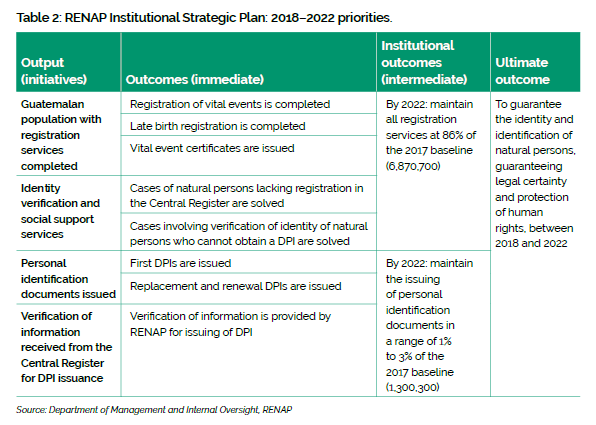
Budgetary allocations and requirements
RENAP’s budget for the 2018 fiscal year was 393,855,691 quetzal (a little over US$53 million) (Table 3). The INE is a smaller institution. Its annual budget was US$3.3 million in 2016; that was boosted to more than US$45 million in 2017 and 2018 in preparation for a population census.
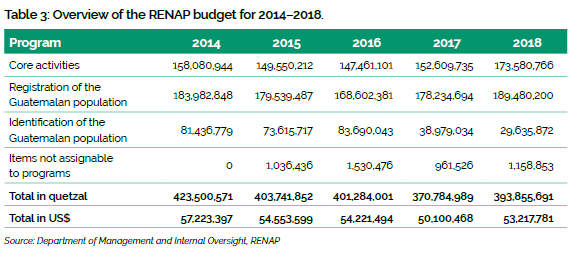
Support from development partners
External support to Guatemala’s CRVS system has been declining. At present, organizations that provide support include:
- Family Search (archive processes);
- United Nations Population Fund (implementation of the INE work plan);
- Viva: Juntos por la Niñez Foundation (birth registration);
- Organization of American States (registration in border areas);
- Pan American Health Organization (cause-of-death registration);
- Statistics Sweden (capacity building in statistics); and
- United Nations Children’s Fund (child data generation).
The main investments from international cooperation donors have concentrated on combating malnutrition, promoting maternal and child health, security, and fighting against corruption. That assistance does not necessarily take into account the importance of access to civil identity and strengthening the CRVS system for
public policy design and effective social program implementation.
Additional Materials
Websites
Additional materials
Calderón, E. 2019. Registros civiles y oficinas de identificación. Inter-American Development Bank.
publications.iadb.org/publications/spanish/document/Registros_civiles_y_oficinas_de_identificación_análisis_y_fichas_de_país_es.pdf
National Statistics Institute (INE). 2018. Estadísticas continuas: Estadísticas Vitales [Ongoing Statistics: Vital Statistics.] ine.gob.gt/index.php/estadisticas/tema-indicadores
Organization of American States and International Development Research Centre. 2018. Mapping of the Civil Registration and Vital Statistics System in Guatemala.
RENAP. 2018. Public Information: Budget 2018. Renap.gob.gt/informacion-publica
RENAP. 2016. Service fees according to Board of Directors Decision No. 67-2016. Renap.gob.gt/sites/default/files/contenido-pdf/tarifarioservicios-acuerdo-67-2016.pdf
Conclusion
The CRVS system in Guatemala has evolved considerably since RENAP was created. Thanks to the modernization of processes and civil registration systems, the goal of achieving complete birth registration is within reach. Following the example of many countries in Latin America, civil registration and identity management in Guatemala are entrusted to one government agency that retains constitutional autonomy. Although RENAP was designed to operate as a single authority responsible for registration processes, over time the agency expanded its cooperation with other public actors, most notably the heath sector. Expanding the locations of registration services to include health facilities was key to achieving higher rates of timely registration of births and deaths. Opportunities for interoperability — thanks to new information and communications technologies, and a unique identification number — have elevated RENAP’s position within the broader public governance system. RENAP has become the main supplier of legal identity of the population for other government agencies that provide citizen-oriented services.
Endnotes
[footnotes]
Annex
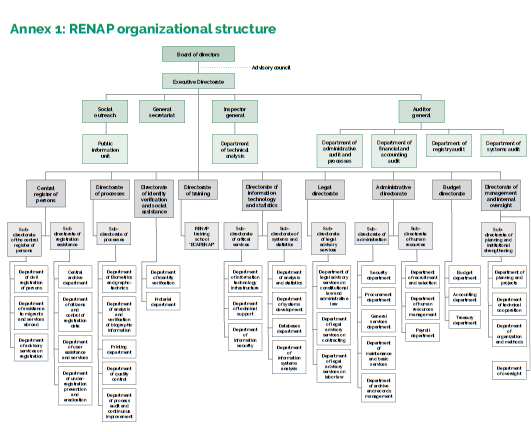
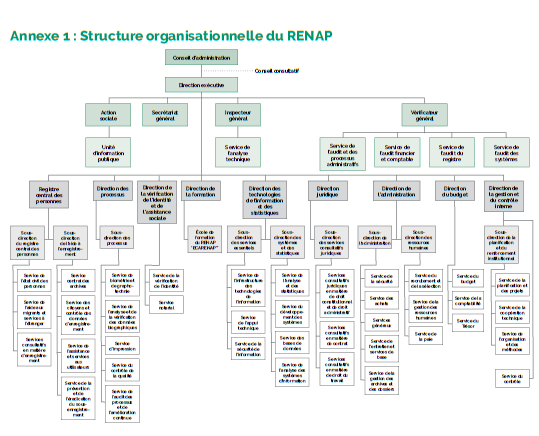
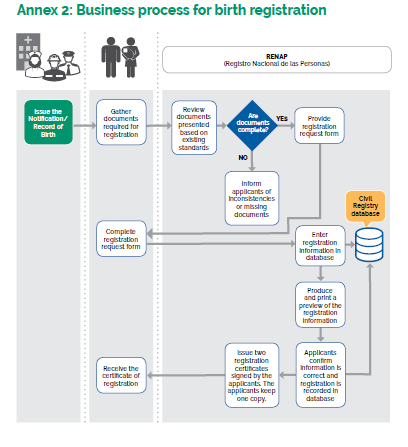

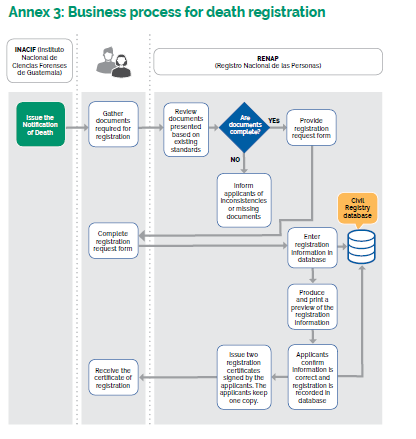
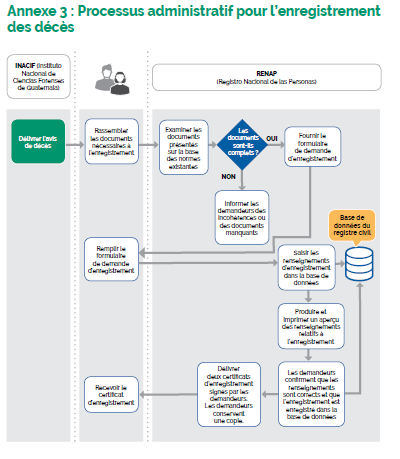
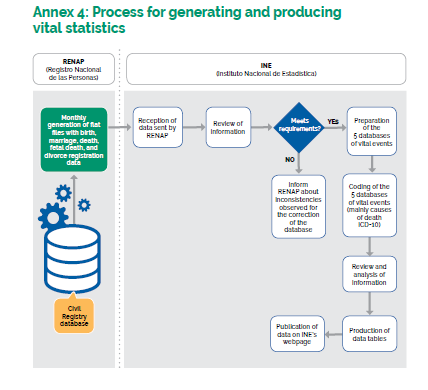
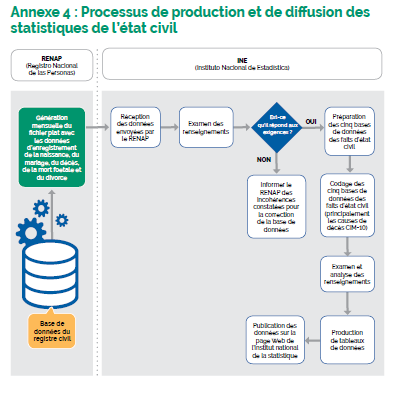
Annex 1: RENAP organizational structure / Annexe 1 : Structure organisationnelle du RENAP
Annex 2: Business process for birth registration / Annexe 2 : Processus administratif pour l’enregistrement des naissances
Annex 3: Business process for death registration / Annexe 3 : Processus administratif pour l’enregistrement des décès
Annex 4: Process for generating and producing vital statistics / Annexe 4 : Processus de production et de diffusion des statistiques de l’état civil